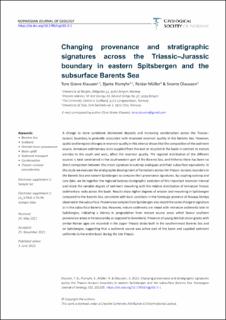| dc.contributor.author | Klausen, Tore Grane | |
| dc.contributor.author | Rismyhr, Bjarte | |
| dc.contributor.author | Müller, Reidar | |
| dc.contributor.author | Olaussen, Snorre | |
| dc.date.accessioned | 2023-03-16T12:17:06Z | |
| dc.date.available | 2023-03-16T12:17:06Z | |
| dc.date.created | 2022-06-21T23:46:47Z | |
| dc.date.issued | 2022 | |
| dc.identifier.issn | 2387-5844 | |
| dc.identifier.uri | https://hdl.handle.net/11250/3058774 | |
| dc.description.abstract | A change to more sandstone dominated deposits and increasing condensation across the Triassic–Jurassic boundary is generally associated with improved reservoir quality in the Barents Sea. However, spatial and temporal changes in reservoir quality in this interval shows that the composition of the sediment source, immature sedimentary rocks supplied from the east or recycled in the basin in contrast to mature arenites to the south and west, affect the reservoir quality. The regional distribution of the different sources is best constrained in the southwestern part of the Barents Sea, and hitherto there has been no direct comparison between the zircon signature in outcrop analogues and their subsurface equivalents. In this study we evaluate the stratigraphic development of formations across the Triassic–Jurassic boundary in the Barents Sea and eastern Spitsbergen to compare their provenance signatures. By coupling outcrop and core data, we tie together the regional tectono-stratigraphic evolution of this important reservoir interval and relate the variable degree of sediment reworking with the relative distribution of immature Triassic sedimentary rocks across the basin. Results show higher degrees of erosion and reworking in Spitsbergen compared to the Barents Sea, consistent with local variations in the forebulge province of Novaya Zemlya observed in the subsurface. Provenance samples from Spitsbergen also record the same change in signature as in the subsurface Barents Sea. However, mature sediments are mixed with immature sediments later in Spitsbergen, indicating a latency in progradation from mature source areas which favour southern provenance areas in Fennoscandia as opposed to Greenland. Presence of young detrital zircon grains with similar Norian ages are recorded in the Upper Triassic strata both in the southernmost Barents Sea and on Spitsbergen, suggesting that a sediment source was active east of the basin and supplied sediment uniformly to the entire basin during the late Triassic. | en_US |
| dc.language.iso | eng | en_US |
| dc.publisher | Geological Society of Norway | en_US |
| dc.rights | Navngivelse 4.0 Internasjonal | * |
| dc.rights.uri | http://creativecommons.org/licenses/by/4.0/deed.no | * |
| dc.subject | Sedimentologi | en_US |
| dc.subject | Sedimentology | en_US |
| dc.subject | Barentsregionen | en_US |
| dc.subject | The Barents Region | en_US |
| dc.subject | Provenansstudier av sedimenter | en_US |
| dc.subject | Provenance of sediments | en_US |
| dc.title | Changing provenance and stratigraphic signatures across the Triassic–Jurassic boundary in eastern Spitsbergen and the subsurface Barents Sea | en_US |
| dc.type | Journal article | en_US |
| dc.type | Peer reviewed | en_US |
| dc.description.version | publishedVersion | en_US |
| dc.rights.holder | Copyright 2022 The Author(s) | en_US |
| dc.source.articlenumber | 202205 | en_US |
| cristin.ispublished | true | |
| cristin.fulltext | original | |
| cristin.qualitycode | 1 | |
| dc.identifier.doi | 10.17850/njg102-2-1 | |
| dc.identifier.cristin | 2034064 | |
| dc.source.journal | Norwegian Journal of Geology | en_US |
| dc.relation.project | Norges forskningsråd: 267689 | en_US |
| dc.subject.nsi | VDP::Geofag: 450 | en_US |
| dc.subject.nsi | VDP::Geosciences: 450 | en_US |
| dc.identifier.citation | Norwegian Journal of Geology. 2022, 102, 202205. | en_US |
| dc.source.volume | 102 | en_US |

